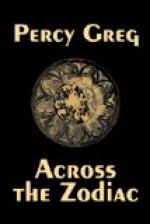As she said this we reached the great road I had crossed on my arrival, and turning up this for a short distance, sufficient, however, to let me perceive that it led to the seaport town of which I have spoken, we came to a break in the central footpath, just wide enough to allow us to pass. Looking back on this occasion, I observed that we were followed by the two other carriages I have mentioned, but at some distance. We then proceeded up the mountain by a narrow road I had not seen in descending it. On either side of this lay fields of the kind already described, one of which was in course of cultivation, and here I saw the ploughs of which my companion had spoken. Evidently constructed on the same principle as the carriages, but of much greater size, and with heavier and broader wheels, they tore up and broke to pieces a breadth of soil of some two yards, working to a depth of some eighteen inches, with a dozen sharp powerful triangular shares, and proceeding at a rate of about fifty yards per minute. Eveena explained that these fields were generally from 200 to 600 yards square. The machine having traversed the whole field in one direction, then recommenced its work, ploughing at right angles to the former, and carrying behind it a sort of harrow, consisting of hooks supported by light, hollow, metallic poles fixed at a certain angle to the bar forming the rearward extremity of the plough, by which the surface was levelled and the soil beaten into small fragments; broken up, in fact, as I had seen, not less completely than ordinary garden soil in England or Flanders. When it reached the end of its course, the plough had to be turned; and this duty required the employment of two men, one at each end of the field, who, however, had no other or more difficult labour than that of turning the machine at the completion of each set of furrows. In another field, already doubly ploughed, a sowing machine was at work. The large seeds were placed singly by means of an instrument resembling a magnified ovipositor, such as that possessed by many insects, which at regulated intervals made a hole in the ground and deposited a seed therein. Eveena explained that where the seed and plant were small, a continuous stream was poured into a small furrow made by a different instrument attached to the same machine, while another arm, placed a little to the rear, covered in the furrow and smoothed the surface. In reply to another question of mine—“There are,” she said, “some score of different wool or hair bearing animals, which are shorn twice in the year, immediately after the rains, and furnish the fibre which is woven into most of the materials we use for dress and other household purposes. These creatures adapt themselves to the shearing machines with wonderful equanimity and willingness, so that they are seldom or never injured.”
“Not even,” I asked, “by inexperienced or clumsy hands?”
“Hands,” she said, “have nothing to do with the matter. They have only to send the animal into the machine, and, indeed, each goes in of his own accord as he sees his fellow come out.”




